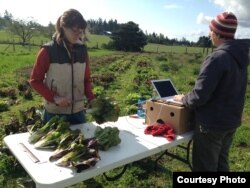The rise of multi-national grocery chains, large-scale food production, and year-round availability of many fruits and vegetables has some clear consumer benefits... convenience and lower costs to name just two. It also has drawbacks that you can touch and taste, such as hard tomatoes and bland strawberries.
Now at selected greenhouses, small farms and research plots across the United States, there's a flavor renaissance afoot, as breeders, farmers, chefs and seed growers collaborate to create more flavorful vegetable varieties - some with more vitamins too.
Oregon State University plant breeder Jim Myers explained this wasn't some miracle of genetic engineering.
"What I do is conventional breeding or traditional breeding, if you will. There is plenty of genetic variation out there for us to work with," he said.
Careful cross-pollination
Myers' lab in Corvallis cross-pollinates related plants with desired traits. In the warm, humid greenhouses, graduate research assistants wield fine tweezers to insert specific pollen into the blooms of broccoli plants on one bench and pole beans in another. On some plants, the researchers tape the blossoms closed afterwards to make sure no other genetic material intrudes. Hanging tags which describe what varieties were crossed make the broccoli row look like miniature Christmas trees.
The plan is to select the best of the results for commercialization. OSU has already released trademarked tomato varieties with names such as Indigo Rose and Indigo Cherry Drops. The deep purple fruits contain higher levels of nutrition.
Myers says his next release may be a mild habanero pepper. He gathers his team together in the greenhouse for a taste test of multi-colored pickled peppers.
The consensus?
"A little bit of kick. But it's not overwhelming," said one team member. "My mouth is not burning... It has a little bit of smokiness."
"A little bit of sweetness too I think," observed Lyle Wallace, one of Myers' students.
"It's much more floral of a flavor than your regular roasted red pepper," added Abi Graham, another lab assistant.
On Marrowstone Island in Puget Sound, Organic Seed Alliance executive director Micaela Colley recently checked on a trial evaluation of purple broccoli and other new crop varieties. The project at the Washington State University Extension research farm is one of several breeding partnerships her organization is involved in.
"We've been selecting for cold hardiness," Colley said, describing another direction vegetable breeding is going. This goal is an extended growing season in the Pacific Northwest. "We've been trying to support year-round availability of crops," she added. Storage onions, chicory and cabbage are also part of those trials.
Colley said large vegetable producers "didn't breed flavor out intentionally" over recent decades. As she sees it, it’s a matter of what components of plants received priority. "There's more of an emphasis on shipping, handling and uniformity."
Colley’s OSA has been breeding for other traits like flavor, color and optimal performance in the local climate for years.
"It's not a brilliant new light bulb that just went on, per se. It's a light bulb that went on with the public."
Designer veggies
About two years ago, a research coordinator at Jim Myers' lab started the Culinary Breeding Network to connect breeders around their region with consumers such as chefs. The network's director, Lane Selman, says the aim is to create the heirloom plants of tomorrow. Other phrases tossed around include "designer vegetables" and "artisan" vegetable breeding. An Idaho Statesman columnist labeled some of it, "this year's garden fad."
But it's not a fad, says Phil Simon, a Wisconsin-based vegetable breeder with the federal government's Agricultural Research Service. "I would say we are really returning to our roots as vegetable breeders in looking at flavor and other aspects of consumer quality."
Simon has worked on breeding better carrots for 35 years. He credits the rise of the "local food" movement in North America and other places for putting the focus back on flavor.
"In some cases at least, the much more extensive local production of vegetables translates to local consumers that are looking for good quality product in their vegetables - that they're getting from those local sources - and local growers that are looking for varieties of vegetables that are able to meet those consumer demands."
Some of the new vegetable varieties with dialed-up flavor and nutrition are available in seed catalogs and through nurseries now. Others, like special parsleys, Asian greens and that mild habanero pepper are still being refined.







